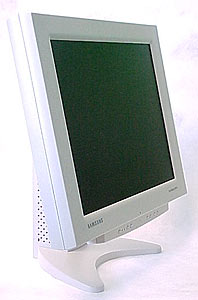Brightness:
The brightness of 800TFT is a
bit lower than other models we've look at numerically speaking. From our perspective, it is
difficult to see any perceptible difference between a brightness or luminance of 200cd/m2 and 170cd/m2. The 800TFT
sits at the latter. Contrast is quite good, and with a ratio of 220:1, the display
is not dull or monotone in any way. Generally contrast ratios range from 150:1 to 300:1. With its' 220:1
ratio the 800TFT sits on the higher end of the
scale.
Resolution:
The dot
pitch for this panel is 0.2805mm. That means the every pixel on this display measures
0.2805mm. Thus when the panel is displaying a thin diagonal line, there is less chance
for that line to appear stepped, or blocky.
Viewing Angle: In the old
days laptop screens used to be notorious for having very narrow viewing angles. While the 800TFT is obviously not a
display intended for a notebook, the same kinds of constraints apply. In
this case the panel has an incredibly wide viewable angle. 80/80/80/80 is essentially as high as this
range can go and means that if your are looking at the display from a
very obtuse angle the picture will still be vibrant, and not grayed
over by means of optical effects.
Resolutions: 1280x1024 is quite large, and
it is important to note the limitations on the video card may not allow it
to support the ideal resolution of this display. High quality video cards
shouldn't have a problem, but it is always a good idea to double check
first. The cost of the 800TFT is high, and being forced to use it at a
less than optimal resolution is not really acceptable. Luckily, the
price of video cards these days are fairly low, and newer and faster
adapters will continue to assure that. Running the display at any resolution
less than 1280x1024 will cause the image to dither.
Conclusions on the 800TFT
To be blunt, the first
impression this LCD display had on us was "it's too big." That
impression was amplified when we went into our display properties
an reset the screen resolution to 1280x1024! After the first few initial hours of usage we settled
in quite nicely to the large display.
While we were unable to test out the display
quality of the Sun 13W3 connector, the analog connection seemed perfectly fine
to us. The display was quite sharp, and the range of gray scales and colours was
more than sufficient to compete with a high-end CRT. LCD's typically
display a range of colour gradations which are less than their old tube
counterparts, but in most circumstances this will not
be obviously.
With the 800TFT's visible area of
18.1" it can easily complete with any 19" CRT, and at only a fraction of
the desk space. The extra wide viewing angles were a treat and allowed us
to treat the display more along the lines of a CRT, than
a LCD. If we had to move off to one side while working, there were no
issues the screen becoming unintelligible.
The OSD is easy to
operate if adjustments need to be made, but we really preferred
to stick with the automatic adjustment key located on the front of the
bezel. The analog display connection is still very much in use, and by
supporting this legacy device (not to mention the 13W3) the 800TFT assures
itself a place in the upgrade path of many a person. Is this display meant for
the average user? Not really. Because of the high cost of basically any LCD panel over the 15" mark
this display is going to be out of the reach of most people.
It is designed to work with high end SGI and Sun boxes,
not to mention standard displays. With a resolution of 1289x1024 it is a
treat on the eyeballs and one that would make anyone want
to work on AutoCAD or Maya all day long.
We would have liked to have seen more
vertical adjustments in the base of the display, and obviously a lower price tag
- but its' picture will not disappoint.
